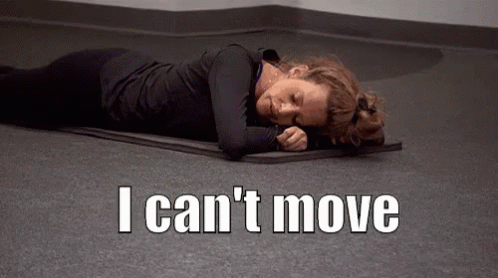Guilty of over training? As aerialists, we love pushing our bodies to the limit. We are always convincing our bodies to do some pretty amazing things. But, how much is too much?
To become better aerialists, we want to take all the classes and train all the time. But we also need to pair the training with enough rest so that our bodies can properly recover and become stronger. If we don’t get enough rest after a prolonged period of time, we reach a state of over training. Think of this as “chronic under-recovery.” Over training greatly increases our risks of injury and burnout, so it is important to avoid.
Personally, when I over train or even over teach, I experience pain around my neck and tendonitis in my elbows and knees (inflammation of tendons). The only way I’ve found to relive it is to take a few days off aerial and ice my inflamed areas, if I continue to push myself the pain can become chronic.
Here are some signs that you might be over training:
Chronic pain/soreness and inflammation
Perceived increase in effort (It feels like it takes more effort to do things you normally do)
Regression of capabilities
Poor sleep quality but increased fatigue symptoms
Loss of muscle mass
Impaired coordination
Decreased endurance
Increase in blood pressure
Mood swings or lack of motivation
Decrease in appetite
Decreased immune system (you get headaches and colds more easily)

If you are experiencing these symptoms, it might be time to take a training break and assess potentially stressful factors in your life. These can be affecting your recovery time between training sessions. Make sure you are getting adequate nutrition, enough sleep, and assess other life stressors like relationship and work stress. Also, consider consulting a physical therapist, acupuncturist, nutritionist or other medical professional that suits your needs.
Here are some tips on preventing over training in the first place:
Get plenty of rest! It can be tempting when experiencing fatigue and a plateau in aerial to go even harder and push yourself even further. However, this is the time to hit pause on that studio membership and reassess. Start by taking 3-7 days off of aerial. We know it may be challenging but your body will thank you later! During those days, try to aim for a full 8 or 9 hours of sleep!
Consider a period of active rest every so often (maybe every 1-4 weeks, depending on how regularly you do aerial). Active rest activities could include walking, swimming, light yoga, Pilates, or another form of cross training that you can do in a leisurely manner. The idea of active rest is to do something that is not aerial that still allows you to be active, and may help correct some training imbalances you may be experiencing due to aerial. This is to give you time to rehabilitate minor injuries and refresh both physically and mentally before beginning a new aerial training period.
Nourish yourself with adequate nutrition--macros (fat, protein, carbs), vitamins, and minerals are all important!
Make sure you are getting plenty of water and avoid consuming large amounts of alcohol, sugar, and other things that stress your system and cause inflammation.
Consider getting a massage to increase blood flow, rid the body of built-up lactic acid, and loosen up tight muscles. If possible, try to make these a regular occurrence!
Make sure your aerial training involves a good warm-up and cool down for injury prevention and to give yourself time to assess how your body is feeling.
Please do not try to fast forward recovery or ignore signals your body is sending. The more you push through, the worse the potential ramifications. Though you may be tempted to keep going and keep pushing, taking care of your body is paramount to ensuring that you can keep flying for years to come!
Are you injured? We came cross this blog post by Lacy Alana that has some great tips on how to cope: https://yesandbrain.com/blog/survivinginjury
Sources Used: Haff, G. Gregory and N. Travis Triplett. Essentials of Strength Training and Conditioning. NSCA, 2016.
Low, Steven. Overcoming Gravity: A Systematic Approach to Gymnastics and Bodyweight Strength. Battle Ground Creative, 2016.
